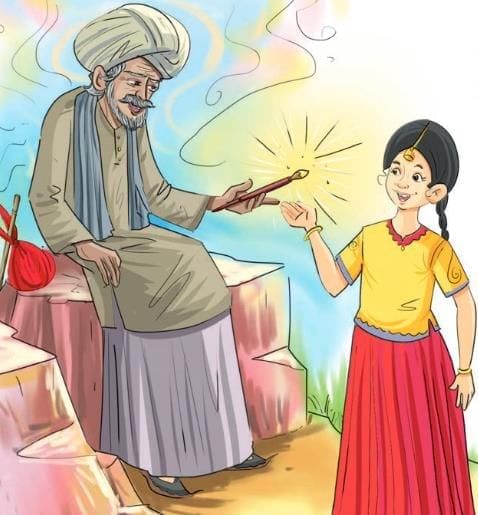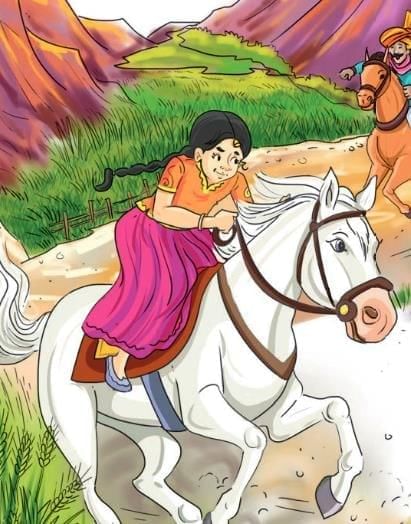Short and Long Answer Questions: The Magic Brush of Dreams | English Poorvi Class 8 - New NCERT PDF Download
Short Answer Questions
Q1. What instructions did the old man give Gopi about the use of the magic brush?
Ans: The old man handed Gopi the brush secretly and warned her not to use it for the wealthy or greedy. Instead, he instructed her to paint only for the poor and needy. This showed that the brush was meant as a blessing for those who suffered hardships, not for selfish gain. His guidance gave Gopi a strong sense of duty and responsibility.
Q2. How did Gopi use the magic brush to help the villagers?
Ans: Gopi used the brush to paint useful things like food, clothes, and tools for her villagers. She painted khichdi for hungry people, a muffler for a farmer, a shawl for a grandmother, and a plough for a man. These paintings turned into real objects, bringing comfort and happiness to the poor. Her kindness made her beloved in the village.
Q3. Why did the Zamindar want the magic brush, and how did he misuse his power?
Ans: The greedy Zamindar wanted Gopi to paint him a tall fortress, gold, jewels, and treasures so he could become even more powerful. He tried to force Gopi into obeying him by threatening her and imprisoning her. His selfishness contrasted with Gopi’s compassion, showing how power in the wrong hands leads to cruelty and corruption.
Q4. How did Gopi cleverly escape from the Zamindar’s prison?
Ans: While locked in the cell, Gopi painted a strong horse and a road leading outside the prison gates. The horse came to life, and she quickly rode out, escaping her captors. Her cleverness and courage helped her outsmart the Zamindar’s men. This showed that her creativity was stronger than their force.
Q5. What happened when the Zamindar and his men chased Gopi?
Ans: To protect herself, Gopi painted a wide river with strong currents. The Zamindar and his men could not cross it. When they continued threatening, Gopi warned she could paint a beast to devour them. Terrified, the Zamindar promised to leave her alone forever. His fear showed that greed always leads to downfall.
Long Answer Questions
Q1. Describe Gopi’s character in the poem. What qualities make her special?
Ans: Gopi is shown as a simple, innocent, and imaginative girl. Instead of collecting beans, rice, or mangoes as her family asked, she spent her time drawing in the sand, showing her love for art. When she received the magic brush, she used it selflessly for the benefit of the poor, painting food, clothes, and tools for them. She remained humble, refusing to use the brush for greed or wealth. Even in difficult situations, such as when the Zamindar imprisoned her, she was brave and resourceful. Her kindness, creativity, and courage make her truly special and a hero in the eyes of her villagers.
Q2. Explain how the poem contrasts the values of generosity and greed.
Ans: The poem clearly sets up Gopi as a symbol of generosity and the Zamindar as a symbol of greed. Gopi used the magic brush only for the poor, making sure her paintings helped those in need. She brought food, warmth, and happiness to the villagers without expecting anything in return. On the other hand, the Zamindar demanded riches, jewels, and fortresses for himself, showing his selfishness. He even punished Gopi for refusing his orders. However, in the end, his greed led to fear and defeat, while Gopi’s kindness and courage won her respect and love. This contrast teaches the moral that goodness and generosity are more powerful than greed.
Q3. What is the central message of “The Magic Brush of Dreams”? How is it conveyed through the story?
Ans: The central message of the poem is that talent and power should be used for helping others, not for selfish desires. This is conveyed through the story of Gopi, who always painted for the needy and brought joy to her village. The magic brush symbolises creativity and responsibility, and Gopi used it wisely. The Zamindar, however, wanted to misuse the brush for personal gain, but his greed brought him failure. In the end, the villagers celebrated Gopi for her kindness, showing that compassion and selflessness bring true victory. The poem conveys the timeless value of using gifts for the greater good of society.
|
59 videos|434 docs|57 tests
|
FAQs on Short and Long Answer Questions: The Magic Brush of Dreams - English Poorvi Class 8 - New NCERT
| 1. What is the central theme of "The Magic Brush of Dreams"? |  |
| 2. Who are the main characters in "The Magic Brush of Dreams"? |  |
| 3. How does the magical brush impact the protagonist's life? |  |
| 4. What moral lessons can be learned from "The Magic Brush of Dreams"? |  |
| 5. How does "The Magic Brush of Dreams" inspire young readers? |  |
















